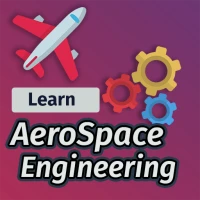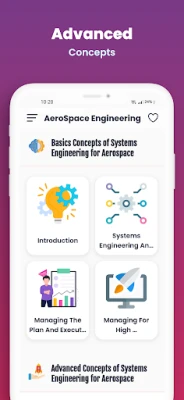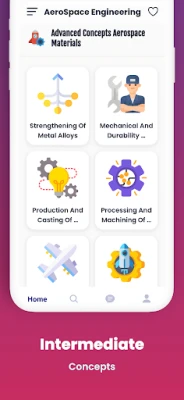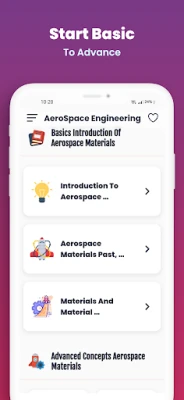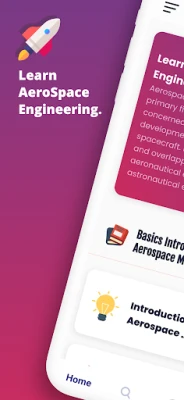
Latest Version
1.1.0
October 30, 2025
CODE WORLD
Education
Android
0
Free
com.codeworld.learnaerospaceengineering
Report a Problem
More About Learn AeroSpace Engineering
Unlocking the World of Aerospace Engineering: A Comprehensive Guide
Aerospace engineering, often referred to as aeronautical or astronautical engineering, is a dynamic field dedicated to the design, development, construction, testing, and operation of vehicles that navigate both the Earth's atmosphere and outer space. This article delves into the intricacies of aerospace engineering, exploring its significance, materials, and the future of this exciting discipline.
Understanding Aerospace Engineering
Aerospace engineering encompasses two primary branches: aeronautical engineering, which focuses on aircraft that operate within the Earth's atmosphere, and astronautical engineering, which deals with spacecraft designed for outer space. This field combines principles from various engineering disciplines, including mechanical, electrical, and materials engineering, to create innovative solutions for air and space travel.
The Importance of Aerospace Materials
Materials play a crucial role in aerospace engineering. The selection of appropriate materials directly impacts the performance, safety, and efficiency of aircraft and spacecraft. Understanding aerospace materials involves examining their past, present, and future applications.
Aerospace Materials: Past, Present, and Future
Historically, aerospace materials have evolved from traditional metals to advanced composites. Today, engineers utilize a variety of materials, including aluminum, titanium, and advanced composites, to enhance performance and reduce weight. The future of aerospace materials lies in the development of smart materials and nanotechnology, which promise to revolutionize the industry.
Material Requirements for Aerospace Structures and Engines
Aerospace structures and engines demand materials that can withstand extreme conditions, including high temperatures, pressure variations, and fatigue. Engineers must consider factors such as strength, weight, and corrosion resistance when selecting materials for these applications.
Strengthening Metal Alloys
Metal alloys are essential in aerospace engineering due to their strength-to-weight ratio. Techniques such as heat treatment and alloying enhance the mechanical properties of these materials, making them suitable for critical components in aircraft and spacecraft.
Mechanical and Durability Testing of Aerospace Materials
Testing is vital to ensure the reliability and safety of aerospace materials. Mechanical testing evaluates properties such as tensile strength, fatigue resistance, and impact toughness, while durability testing assesses how materials perform under prolonged exposure to environmental conditions.
Production and Casting of Aerospace Metals
The production and casting processes for aerospace metals are highly specialized. Techniques such as investment casting and additive manufacturing allow for the creation of complex geometries while maintaining the integrity of the material.
Processing and Machining of Aerospace Metals
Machining processes, including milling, turning, and grinding, are critical for achieving the precise tolerances required in aerospace components. Advanced machining techniques ensure that parts meet stringent specifications while minimizing waste.
Aluminum Alloys for Aircraft Structures
Aluminum alloys are widely used in aircraft structures due to their lightweight and corrosion-resistant properties. These alloys provide the necessary strength while contributing to fuel efficiency and overall performance.
Titanium Alloys for Aerospace Structures and Engines
Titanium alloys are favored in aerospace applications for their high strength-to-weight ratio and resistance to extreme temperatures. These materials are commonly used in engine components and airframe structures, enhancing performance and durability.
Magnesium Alloys for Aerospace Structures
Magnesium alloys are among the lightest structural materials available, making them ideal for aerospace applications. Their low density contributes to weight savings, which is crucial for improving fuel efficiency in aircraft.
Steels for Aircraft Structures
While not as lightweight as aluminum or titanium, high-strength steels are essential for specific aerospace applications. Their toughness and fatigue resistance make them suitable for critical components that require durability and reliability.
Systems Engineering and Integration
Systems engineering is a holistic approach that integrates various engineering disciplines to ensure the successful development of aerospace systems. This process involves managing the plan and execution phases, focusing on high performance, and implementing effective integration strategies.
Managing the Plan and Execute Phases
Effective project management is crucial in aerospace engineering. Engineers must develop comprehensive plans that outline project goals, timelines, and resource allocation to ensure successful execution.
Managing for High Performance
High performance in aerospace engineering requires continuous improvement and innovation. Engineers must adopt best practices and leverage advanced technologies to enhance system performance and reliability.
Integration Plan and Test Strategy
Developing a robust integration plan is essential for ensuring that all components of an aerospace system work together seamlessly. Testing strategies must be implemented to validate system performance and identify potential issues before deployment.
Managing People, Product, and Process (P3) Implementation
Successful aerospace projects rely on effective management of people, products, and processes. Implementing a P3 approach fosters collaboration, enhances communication, and drives project success.
Systems Engineering Fundamentals
Understanding the fundamentals of systems engineering is vital for aerospace engineers. This knowledge enables them to design and develop complex systems that meet stringent requirements and perform reliably in challenging environments.
Why Pursue a Career in Aerospace Engineering?
Graduates of aerospace engineering play a pivotal role in advancing technology and improving society. Their work extends beyond aircraft and spacecraft design, impacting various industries, including biomedical, computer, and automotive sectors. By pursuing a career in aerospace engineering, individuals contribute to groundbreaking innovations that shape the future of transportation and exploration.
In conclusion, aerospace engineering is a multifaceted field that combines creativity, technical expertise, and a passion for innovation. As technology continues to evolve, the demand for skilled aerospace engineers will only increase, making this an exciting and rewarding career choice.
If you found this guide on aerospace engineering informative, please consider leaving a comment and rating us with 5 stars ★★★★★. Thank you!
Rate the App
User Reviews
Popular Apps










Editor's Choice










